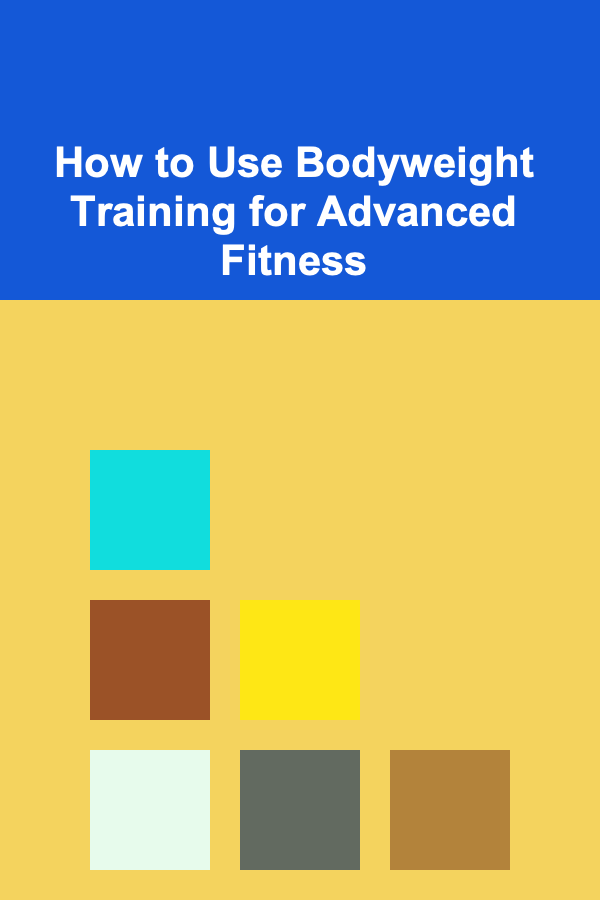
How to Use Bodyweight Training for Advanced Fitness
ebook include PDF & Audio bundle (Micro Guide)
$12.99$5.99
Limited Time Offer! Order within the next:

Bodyweight training is a form of physical exercise where an individual uses their own body weight to build strength, flexibility, endurance, and overall fitness. While it is often associated with beginners or those new to fitness, bodyweight training can be just as effective, if not more, for advanced athletes and fitness enthusiasts. The beauty of bodyweight exercises lies in their versatility, accessibility, and scalability, making them an ideal tool for individuals at any fitness level, including those looking to take their training to the next level.
This article explores how advanced fitness enthusiasts can use bodyweight training to enhance their performance, achieve new goals, and break through fitness plateaus. We will delve into the science behind bodyweight training, discuss advanced bodyweight exercises, and provide actionable strategies for incorporating bodyweight exercises into an advanced fitness regimen.
Understanding the Science Behind Bodyweight Training
Before diving into the exercises, it's important to understand why bodyweight training works, particularly for advanced athletes. The human body is designed to move in various planes of motion, and bodyweight exercises exploit this natural movement to improve functional strength. Functional strength refers to strength that is directly transferable to real-world activities, such as lifting groceries, climbing stairs, or sprinting. Unlike machines or weights, bodyweight exercises involve multi-joint, compound movements that mimic the body's natural motion patterns, improving overall coordination, balance, and muscle activation.
For advanced athletes, bodyweight training can offer several benefits:
- Increased Core Activation: Many bodyweight exercises engage the core muscles in ways that traditional weightlifting does not. This promotes stability, posture, and injury prevention.
- Improved Joint Mobility: Bodyweight exercises encourage natural movement patterns, promoting flexibility and range of motion in the joints, which can help prevent injuries and improve athletic performance.
- Time Efficiency: Since bodyweight exercises do not require external equipment, they are easy to incorporate into a busy schedule. The flexibility of training anywhere at any time makes bodyweight exercises a valuable tool for advanced athletes.
- Improved Muscle Endurance: Advanced bodyweight exercises can be performed in a way that challenges muscle endurance, pushing the muscles to work for longer periods of time with minimal rest.
- Focus on Movement Quality: Because bodyweight exercises involve a greater emphasis on form and control, they force athletes to hone their movement quality. This can translate into better performance in other forms of training.
Now that we understand the science behind bodyweight training, let's dive into the types of exercises and strategies that advanced fitness enthusiasts can use to enhance their strength, mobility, and endurance.
Advanced Bodyweight Exercises
For advanced athletes, the focus should shift from simple movements to more complex and challenging exercises that demand strength, coordination, and body control. The following are some advanced bodyweight exercises that can be incorporated into an advanced fitness regimen.
1. Pistol Squats
Pistol squats are a unilateral bodyweight exercise that requires a high level of strength, balance, and mobility. This exercise targets the quadriceps, hamstrings, glutes, and core muscles, while also improving flexibility in the hips and ankles. To perform a pistol squat:
- Stand with your feet hip-width apart and extend one leg forward.
- Squat down on the standing leg while keeping the extended leg off the ground.
- Lower your body until your thigh is parallel to the ground, ensuring your knee does not pass over your toes.
- Push through the heel of your standing leg to return to the starting position.
2. Handstand Push-Ups
Handstand push-ups are an advanced variation of the traditional push-up, requiring both shoulder and core strength. They also engage the upper back and arms. To perform a handstand push-up:
- Start by kicking up into a handstand position with your feet against a wall for support.
- Slowly lower your body toward the ground by bending your elbows.
- Once your head nearly touches the ground, press through your hands to return to the starting position.
3. Dragon Flags
The dragon flag is one of the most challenging core exercises. It requires incredible core strength and control, as well as stability in the shoulders and upper body. To perform a dragon flag:
- Lie flat on a bench or the floor and hold onto a sturdy object behind your head.
- Raise your legs and torso in a straight line, keeping your body rigid from head to toe.
- Lower your body down slowly while maintaining control, keeping your legs extended and your body in a straight line.
- Reverse the movement and return to the starting position.
4. Clapping Push-Ups
Clapping push-ups are a powerful plyometric variation of the traditional push-up that targets explosive strength, particularly in the chest, shoulders, and triceps. To perform a clapping push-up:
- Begin in a traditional push-up position with your hands slightly wider than shoulder-width apart.
- Lower your body to the ground as you would in a regular push-up.
- Push yourself off the ground explosively, clapping your hands together before landing back in the push-up position.
- Make sure to land softly to protect your wrists and shoulders.
5. Muscle-Ups
Muscle-ups combine a pull-up with a dip and are an excellent exercise for upper-body strength. They primarily target the lats, chest, shoulders, and arms. To perform a muscle-up:
- Begin by hanging from a bar with your hands slightly wider than shoulder-width apart.
- Perform a pull-up, but as your chin passes the bar, push your chest over the bar and transition into a dip.
- Push yourself up until your arms are fully extended, and then lower yourself back down into the starting position.
6. L-Sit to Handstand
This exercise combines the L-sit, a core-strengthening move, with a handstand. It requires advanced strength and coordination to transition from a seated position to a vertical one. To perform an L-sit to handstand:
- Start in an L-sit position with your legs extended in front of you and your hands placed on the floor.
- Lift your hips off the ground and, using core strength, press into your hands to transition into a handstand position.
7. One-Arm Push-Ups
The one-arm push-up is a challenging variation of the traditional push-up that requires tremendous upper-body and core strength. To perform a one-arm push-up:
- Start in a standard push-up position but place one hand behind your back or across your chest.
- Perform a push-up while maintaining balance and control.
- Keep your core engaged and ensure that your body moves as a single unit.
8. Planche Push-Ups
Planche push-ups are an advanced bodyweight exercise that requires significant shoulder and core strength. The movement involves pushing up while in a planche position, where the body is held parallel to the ground with the hands supporting the weight. To perform planche push-ups:
- Start by positioning your hands on the ground, just outside shoulder-width.
- Shift your body forward, lifting your feet off the ground, and balance on your hands.
- Lower your body by bending your elbows, then press back up to the starting position.
Incorporating Bodyweight Training into an Advanced Fitness Regimen
Now that we have explored some advanced bodyweight exercises, let's discuss how to effectively incorporate them into an advanced fitness regimen.
1. Periodization
Periodization refers to the systematic planning of training phases that aim to optimize performance and prevent overtraining. For advanced athletes, bodyweight training can be incorporated into a periodized plan to target different aspects of fitness, such as strength, hypertrophy, endurance, and power. A typical periodized program might include:
- Strength phase: Focus on low-rep, high-intensity bodyweight exercises such as handstand push-ups, muscle-ups, and pistol squats.
- Hypertrophy phase: Perform moderate-rep, moderate-intensity bodyweight exercises with a focus on muscle growth, such as clapping push-ups and L-sit to handstand.
- Endurance phase: Incorporate high-rep, low-intensity exercises with minimal rest, such as push-ups, bodyweight squats, and lunges.
- Power phase: Focus on explosive exercises like plyometric push-ups, jump squats, and clapping push-ups.
2. Progressive Overload
Progressive overload is a key principle for increasing strength and performance in any form of training, including bodyweight exercises. To progressively overload with bodyweight exercises, advanced athletes can:
- Increase the difficulty of exercises (e.g., from regular push-ups to clapping push-ups or from regular squats to pistol squats).
- Add more reps or sets as strength improves.
- Decrease rest periods between sets to improve muscular endurance.
- Manipulate leverage (e.g., performing handstand push-ups or planche push-ups).
3. Use Compound Movements
Incorporating compound movements---exercises that engage multiple muscle groups---can help optimize bodyweight training. Focus on exercises like muscle-ups, dragon flags, and pistol squats, which work multiple muscle groups at once and require greater coordination and energy expenditure.
4. Mobility and Flexibility
Bodyweight training should also include movements that improve joint mobility and flexibility. Exercises like yoga or dynamic stretching before and after workouts can help improve range of motion and prevent injury.
5. Active Rest and Recovery
Rest and recovery are essential for any advanced fitness routine. Active rest techniques, such as performing low-intensity exercises during rest periods or incorporating mobility work into recovery days, can help maintain muscle activation and promote recovery.
Conclusion
Bodyweight training is a powerful tool for advanced athletes who want to build strength, endurance, and flexibility without relying on external equipment. By incorporating challenging exercises like pistol squats, handstand push-ups, and muscle-ups, athletes can continue to push the limits of their fitness. Additionally, using strategies like progressive overload, periodization, and compound movements can ensure continuous improvement and optimal results.
While bodyweight training may seem simple at first glance, its potential for advanced athletes is immense. With the right exercises, techniques, and training principles, bodyweight exercises can be just as effective, if not more, than traditional weightlifting or gym-based routines. Whether you are training at home, outdoors, or in the gym, bodyweight training can help you achieve your fitness goals and break through plateaus, ultimately taking your performance to new heights.

How to Build a Checklist for Capturing Lifestyle Product Photos
Read More
How to Create a Winter Wonderland Feel with Simple Decor Ideas
Read More
How to Save on Home Renovation Costs While Sticking to a Budget
Read More
How to Use Recessed Lighting to Illuminate Your Space
Read More
What Are the Best Ways to Organize Your Books?
Read More
How to Manage Adult Acne and Breakouts
Read MoreOther Products

How to Build a Checklist for Capturing Lifestyle Product Photos
Read More
How to Create a Winter Wonderland Feel with Simple Decor Ideas
Read More
How to Save on Home Renovation Costs While Sticking to a Budget
Read More
How to Use Recessed Lighting to Illuminate Your Space
Read More
What Are the Best Ways to Organize Your Books?
Read More